October 20, 1940. It was on this day, seventy years ago, that Bhagavan Baba unveiled the mystery surrounding His birth, life and mission. He declared to the people around, and through them to the entire mankind, that He indeed is the Supreme Consciousness embodied in a diminutive and delightful form. “I am no longer your Sathya, I am Sai…I have My work; My devotees are calling Me…” He announced candidly on that day.Ever since, this eternal reservoir of energy and empathy, hope and happiness, solace and succor, light and love, has nursed and nurtured, and ensured that the tiny seed of goodness latent within every individual grows into a gigantic tree of love and serenity. And like a perfect teacher, He has demonstrated this more by living that principle in every moment of His own life. The result is a luminescent legacy that will continue to illumine the dark alleys of humanity’s collective consciousness, elevating it to a state of absolute sublimity for generations to come.“Loving Legend – Living Legacies” seeks to capture a few salient highlights of this glorious saga of Pure Love. This 30-episode radio documentary starts on October 20, 2010 on Radio Sai to continue daily till November 19, 2010.Below is the textual adaptation of this audio series embellished with pictures, audio and video clips!Let us immerse ourselves in the story of His glory and more important strive to make our little lives shine with the sacred glow of purity, nobility and genuine compassion.
Episode 2: The Divine Childhood Begins
 |
|
The small boy, Sathya, delighted in placing fresh ash markings on His forehead to the wonder of the peasants and cowherds in the little village of Puttaparthi. He would also take immense pleasure in raiding His sister’s supplies of vermillion to place a round spot on His countenance.
Baba’s biographer, Professor N. Kasturi, writes: “He is Shiva. He is Shakti. He must have both Vibhuthi and Kumkum.”
My Life is My Message – He Leads by Example
Baba’s biographer, Professor N. Kasturi, writes: “He is Shiva. He is Shakti. He must have both Vibhuthi and Kumkum.”
My Life is My Message – He Leads by Example
 |
From an early age, Sathya demonstrated His message through the way He lived and interacted with those around Him. He kept away from places where livestock, fish or fowl were caught or killed. For His meals, Sathya would run to His neighbour Subamma’s house as she maintained a strict vegetarian kitchen.
He rarely retaliated when chided or teased by playmates, and spoke the truth without resorting to the usual childish excuses that a fear-stricken child would offer. Whenever a beggar appeared at the door, Sathya would leave His play to ply them with food. Even when exasperated family members tried stopping Him from indulging in “an expensive and misplaced charity”, Sathya remained resolute in His example of service.
In time, He brought the blind and maimed, as well as the decrepit and the diseased to the front steps of His parents’ house. As His sisters placed rice or grain in the outstretched hands, the Little Master would look on with gladness.
Elementary school in Puttaparthi found students terrified of being punished with a cane for being late. Sathya took pity on the students huddled in the cold before sunrise at the school. He scrounged from His own house to bring shirts, towels, and dhotis. The elders at home had to lock away items of clothing that they could not afford to lose.
His School Days – The Children Find Their True Guru
He rarely retaliated when chided or teased by playmates, and spoke the truth without resorting to the usual childish excuses that a fear-stricken child would offer. Whenever a beggar appeared at the door, Sathya would leave His play to ply them with food. Even when exasperated family members tried stopping Him from indulging in “an expensive and misplaced charity”, Sathya remained resolute in His example of service.
In time, He brought the blind and maimed, as well as the decrepit and the diseased to the front steps of His parents’ house. As His sisters placed rice or grain in the outstretched hands, the Little Master would look on with gladness.
Elementary school in Puttaparthi found students terrified of being punished with a cane for being late. Sathya took pity on the students huddled in the cold before sunrise at the school. He scrounged from His own house to bring shirts, towels, and dhotis. The elders at home had to lock away items of clothing that they could not afford to lose.
His School Days – The Children Find Their True Guru
 |
The boys called their friend “Guru” as it was clear to them that He was their teacher. One particular incident that can be cited as a sign of Baba’s divinity was when the boys came across a temple devoted to Hanuman, the monkey God and Lord Rama’s greatest devotee. The boys decided to take a ritual walk or circumambulation around the installed deity to pay Hanuman their obeisance. Sathya did not join them. The boys were chagrined. They needed their leader, so they dragged Sathya along in spite of His protestations.
He had barely taken a few steps around the temple when a huge monkey appeared on the scene and blocked their progress; the ritual walk had to be stopped because it could not be shooed away. But in no time, the mysterious primate disappeared as suddenly as it had appeared. Later, Sathya revealed that the monkey was indeed Hanuman, protesting that if any circumambulation were to occur, it had to be Hanuman going around Rama, not the other way around. Such were the hints of Sathya’s divinity that multiplied over time.
Sathya had vivid ways of demonstrating the path of dharma. Grandfather Kondamma Raju’s sons and one of his daughters - all lived under the same roof. So, Sathya grew up surrounded by at least 18 children. Those who were clean and straight won peppermints, which Sathya “took out” from empty bags! Once, a tailor was called in to stitch brand new shirts for them all. There were various kinds of coloured cloth.
Young Sathya said, “Let everyone be given the cloth he/she selects; whatever remains is good enough for Me.” So saying, the Lord in a young body looked on in joy at the happiness of the others. This example of selflessness and equanimity made His grandfather proud.
He had barely taken a few steps around the temple when a huge monkey appeared on the scene and blocked their progress; the ritual walk had to be stopped because it could not be shooed away. But in no time, the mysterious primate disappeared as suddenly as it had appeared. Later, Sathya revealed that the monkey was indeed Hanuman, protesting that if any circumambulation were to occur, it had to be Hanuman going around Rama, not the other way around. Such were the hints of Sathya’s divinity that multiplied over time.
Sathya had vivid ways of demonstrating the path of dharma. Grandfather Kondamma Raju’s sons and one of his daughters - all lived under the same roof. So, Sathya grew up surrounded by at least 18 children. Those who were clean and straight won peppermints, which Sathya “took out” from empty bags! Once, a tailor was called in to stitch brand new shirts for them all. There were various kinds of coloured cloth.
Young Sathya said, “Let everyone be given the cloth he/she selects; whatever remains is good enough for Me.” So saying, the Lord in a young body looked on in joy at the happiness of the others. This example of selflessness and equanimity made His grandfather proud.
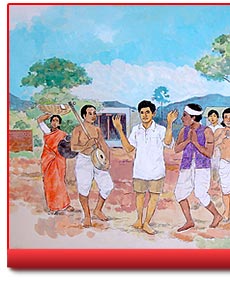 | 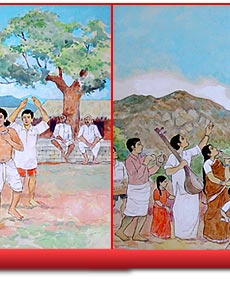 | 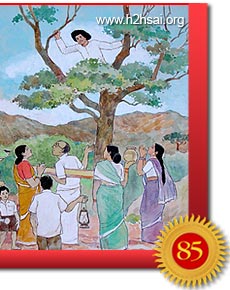 |
Yet another way that young Baba led His playmates towards God was in the founding of a Pandhari bhajan group.
He recruited many of of His friends and got them to dress in matching uniforms and dance to folk melodies describing the yearning for Panduranga’s darshan. An attendant would provide devotional details.
Sathya added stories about Krishna and that of an ‘unknown saint’ named Sai Baba of Shirdi. As the organizer, treasurer, composer and lead singer, He brought to life scenes from Krishna’s childhood among the gopis, including the cows, calves, trees and the river Yamuna. His depiction of the Lion-God Narasimha was so fierce, that He frightened the entire village until offerings of camphor and broken coconuts brought Sathya to normalcy again. So popular did the boys’ performance become that they were invited to neighbouring villages nearly 12 miles away. The boys would walk to these villages carrying their food with them.
When it was time for Sathya to go to middle school, the nearest such institution was in Bukkapatnam, a village several kilometers north of Puttaparthi.
Young Sathya trudged back and forth every day, at times neck-deep in water, carrying His school bag on His head. Making students more God-conscious remained His prime occupation. To hold the attention of His mates, He materialized—out of thin air—candy or savouries for them, much to their amazement.
Young Sathya Shows His Divine Powers
When her children returned from school each day, Mother Easwaramma would make them sit around her and enquire about the happenings in the school that day.
He recruited many of of His friends and got them to dress in matching uniforms and dance to folk melodies describing the yearning for Panduranga’s darshan. An attendant would provide devotional details.
Sathya added stories about Krishna and that of an ‘unknown saint’ named Sai Baba of Shirdi. As the organizer, treasurer, composer and lead singer, He brought to life scenes from Krishna’s childhood among the gopis, including the cows, calves, trees and the river Yamuna. His depiction of the Lion-God Narasimha was so fierce, that He frightened the entire village until offerings of camphor and broken coconuts brought Sathya to normalcy again. So popular did the boys’ performance become that they were invited to neighbouring villages nearly 12 miles away. The boys would walk to these villages carrying their food with them.
When it was time for Sathya to go to middle school, the nearest such institution was in Bukkapatnam, a village several kilometers north of Puttaparthi.
Young Sathya trudged back and forth every day, at times neck-deep in water, carrying His school bag on His head. Making students more God-conscious remained His prime occupation. To hold the attention of His mates, He materialized—out of thin air—candy or savouries for them, much to their amazement.
Young Sathya Shows His Divine Powers
When her children returned from school each day, Mother Easwaramma would make them sit around her and enquire about the happenings in the school that day.
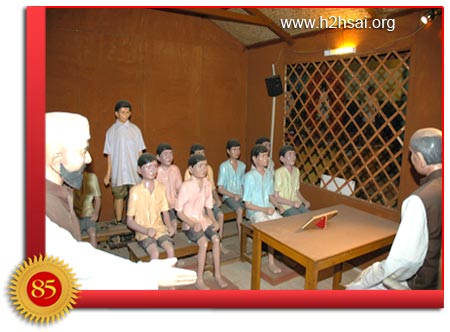 |
One day, in answer to her query, one boy said: “Mother, today one of our teachers made Raju stand up on the bench.”
Unable to bear such criticism against a teacher, Mother Easwaramma said: “My dear children! You should not say anything against your teacher. He must have punished our Sathyam that way, only because He had committed a mistake. No teacher would ever punish his student without a reason. Sathya! Tell me, what wrong did you commit?”
In His Divine Discourse, Bhagavan has Himself narrated the incident as follows:
The teacher ordered: “Whoever has written the notes dictated by me in their note books, put it on my table; others may stand up on the bench.” Since I did not write the notes, I stood up on the bench. However, I explained to the teacher, “Sir! No doubt I did not write the notes dictated by you, but I can answer all the questions put by you.”
Unable to bear such criticism against a teacher, Mother Easwaramma said: “My dear children! You should not say anything against your teacher. He must have punished our Sathyam that way, only because He had committed a mistake. No teacher would ever punish his student without a reason. Sathya! Tell me, what wrong did you commit?”
In His Divine Discourse, Bhagavan has Himself narrated the incident as follows:
The teacher ordered: “Whoever has written the notes dictated by me in their note books, put it on my table; others may stand up on the bench.” Since I did not write the notes, I stood up on the bench. However, I explained to the teacher, “Sir! No doubt I did not write the notes dictated by you, but I can answer all the questions put by you.”
The teacher felt offended by My reply. Expressing his annoyance, he said, “How arrogant You are!” and ordered Me to stand on the bench for three consecutive periods. Meanwhile, our English teacher Mehboob Khan came that way. He was a noble soul. On seeing Me standing on the bench, he enquired [of] that teacher, “Why did you make Him do that?” The teacher explained the matter that I had not written the notes down. Mehboob Khan explained, “It might be true; but He can answer any question you put to Him. Hence, tell Him to sit down on that bench. What you did is a mistake.”
 |
Despite Mehboob Khan’s advice, the teacher Kondappa did not agree with the suggestion. In the meantime, the bell rang signifying the end of this period. The teacher tried to get up from his chair so that he may go to another class. But, he could not get up.
He looked around to see whether his dhoti had got stuck to some nail. It was not so. What had happened was that he himself had got stuck to that chair and hence could not get up.
Mehboob Khan, on seeing the plight of this teacher, told him again, “We should never punish people without a reason, even if they are our students. This boy may appear to you as an ordinary boy. But, there is immense divine power in Him. You ask Him to sit down, at least now.” Kondappa then ordered Me to sit down. The moment I sat down, the teacher could get up from his chair.”
Baba has disclosed that this drama of the teacher getting stuck to his chair was not staged to humiliate the teacher concerned, but to make people conscious of the divine powers that Sathya was born with.
Little Sathya Braves Testing Times with Equanimity
Around this time, Swami’s older brother, Seshama Raju, moved to Kamalapur to train as a teacher at the school there. As it was a good school, Seshama Raju wanted to enroll his younger brother there as well. After all, the whole family had pinned their hopes on Sathya to make it to college and distinguish the family by becoming an officer with the government.
So, Sathya moved to Kamalapur and moved in with Seshama Raju who was residing with his in-laws. It was here that Sathya performed arduous household duties such as fetch drinking water for the family everyday from a far-off well. In keeping with His teachings on forbearance and equanimity, He performed His chores diligently, despite the scars they left on Swami that remain to this day.
Once again, Sathya was a favourite among the teachers and students alike. His drillmaster, who was also His scoutmaster, insisted the boys attend and render service at the General Fair and Cattle show in neighbouring Pushpagiri.
He looked around to see whether his dhoti had got stuck to some nail. It was not so. What had happened was that he himself had got stuck to that chair and hence could not get up.
Mehboob Khan, on seeing the plight of this teacher, told him again, “We should never punish people without a reason, even if they are our students. This boy may appear to you as an ordinary boy. But, there is immense divine power in Him. You ask Him to sit down, at least now.” Kondappa then ordered Me to sit down. The moment I sat down, the teacher could get up from his chair.”
Baba has disclosed that this drama of the teacher getting stuck to his chair was not staged to humiliate the teacher concerned, but to make people conscious of the divine powers that Sathya was born with.
Little Sathya Braves Testing Times with Equanimity
Around this time, Swami’s older brother, Seshama Raju, moved to Kamalapur to train as a teacher at the school there. As it was a good school, Seshama Raju wanted to enroll his younger brother there as well. After all, the whole family had pinned their hopes on Sathya to make it to college and distinguish the family by becoming an officer with the government.
So, Sathya moved to Kamalapur and moved in with Seshama Raju who was residing with his in-laws. It was here that Sathya performed arduous household duties such as fetch drinking water for the family everyday from a far-off well. In keeping with His teachings on forbearance and equanimity, He performed His chores diligently, despite the scars they left on Swami that remain to this day.
Once again, Sathya was a favourite among the teachers and students alike. His drillmaster, who was also His scoutmaster, insisted the boys attend and render service at the General Fair and Cattle show in neighbouring Pushpagiri.
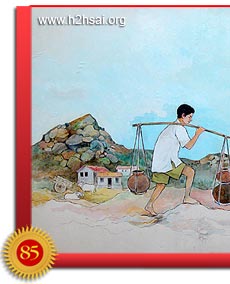 |  |  |
A fee of 10 rupees was collected from each boy for the bus trip and other expenses. Sathya could not afford such an indulgence. Excusing Himself from the group, He nevertheless assured His scoutmaster that He would somehow get there in time for duty. So, while His friends reached the fairgrounds by bus, little Sathya walked the entire distance on foot. When He got to Pushpagiri, He carried out His duties unmindful of the tiredness from the long journey. He even picked up gifts for His family in Kamalapur.
When He returned, what greeted Him was not appreciation for the gifts, but a severe punishment as His absence had interfered with the family’s supply of drinking water!
Swami has revealed to us that He deliberately created such painful situations for Himself to teach humanity the qualities of forbearance and equanimity.
When He returned, what greeted Him was not appreciation for the gifts, but a severe punishment as His absence had interfered with the family’s supply of drinking water!
Swami has revealed to us that He deliberately created such painful situations for Himself to teach humanity the qualities of forbearance and equanimity.
Wolf Messing Seeks the Little Guru
One day, Sathya and a few other students were taking their customary walk by the railroad station when they stopped to sit on a bench.
A white-skinned foreigner saw Sathya through the window of the train approaching the station and tried to get off from the carriage before it could come to a halt. In the bargain, the fellow fell off from the coach.
One day, Sathya and a few other students were taking their customary walk by the railroad station when they stopped to sit on a bench.
A white-skinned foreigner saw Sathya through the window of the train approaching the station and tried to get off from the carriage before it could come to a halt. In the bargain, the fellow fell off from the coach.
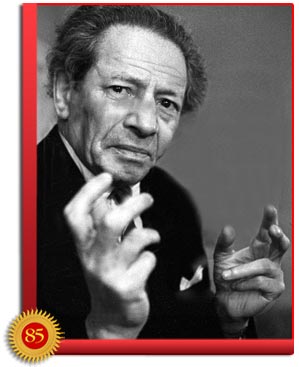 |
Sathya’s fellow students, Ramesh and Suresh, grew anxious that the foreigner would have broken his leg.
Sathya, however, assured his friends: “Nothing has happened. He is coming to see Me only. Hence, no danger will befall him. Please remain calm and quiet.”
The man was named Wolf Messing. Without waiting to collect his luggage from the train that had by then left the station, he ran straight towards Baba, took Him in his arms and kissed Him. With tears pouring down his cheeks, the man cried: “I am so happy. I am so happy.” He then danced in ecstasy, repeating: “I love you, I love you.”
Bhagawan has called Wolf Messing a “powerful spiritual personality” with “a purified consciousness and an insight marked by divine characteristics.”
Ramesh, fearing the man was a lunatic and had come to kidnap Sathya, ran home to bring his father to intervene. Ramesh’s father arrived and hoisted Sathya into the jeep and hid Him in his house. Wolf Messing followed them and sat waiting outside the house. He finally left to return to Russia, leaving behind a pencil-scrawled note on the front door. The note said: “You are most fortunate to keep this boy in your house and serve Him. He is an Embodiment of Divinity. I am not that fortunate. I deserve only this much. Thank you.”
Thus, the secret of Baba’s divinity was proving itself to be global in scope, even as those around Him scratched their heads and wondered at the nature of their little “Guru.”
Sathya, however, assured his friends: “Nothing has happened. He is coming to see Me only. Hence, no danger will befall him. Please remain calm and quiet.”
The man was named Wolf Messing. Without waiting to collect his luggage from the train that had by then left the station, he ran straight towards Baba, took Him in his arms and kissed Him. With tears pouring down his cheeks, the man cried: “I am so happy. I am so happy.” He then danced in ecstasy, repeating: “I love you, I love you.”
Bhagawan has called Wolf Messing a “powerful spiritual personality” with “a purified consciousness and an insight marked by divine characteristics.”
Ramesh, fearing the man was a lunatic and had come to kidnap Sathya, ran home to bring his father to intervene. Ramesh’s father arrived and hoisted Sathya into the jeep and hid Him in his house. Wolf Messing followed them and sat waiting outside the house. He finally left to return to Russia, leaving behind a pencil-scrawled note on the front door. The note said: “You are most fortunate to keep this boy in your house and serve Him. He is an Embodiment of Divinity. I am not that fortunate. I deserve only this much. Thank you.”
Thus, the secret of Baba’s divinity was proving itself to be global in scope, even as those around Him scratched their heads and wondered at the nature of their little “Guru.”
(To be continued)
- Heart2Heart Team
TEXTO TOMADO DE: http://media.radiosai.org/Journals/Vol_08/01OCT10/05-L4_02.htm























No hay comentarios :
Publicar un comentario